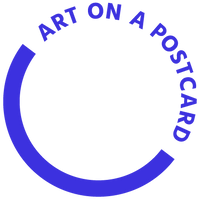Whether status symbols or starkly honest depictions, portraits have served for centuries as potent battlegrounds of emotion and depictions of the individual subconscious process. I can’t think of any other genre of painting that is so concerned with capturing and questioning the existence of the soul, and representing the essence of the individual: that which humanises humanity.
We are very excited to be showcasing two artists this year whose diverse sets of work take on the historical tradition of portraiture and engage it within a contemporary dialogue; ruminating on the challenging, isolating, and confusing nature of individual struggle in the modern world.
Laura Guoke, who holds a BA from Vilnius Academy of Fine Arts and an MA from Siauliai University, is a Lithuanian artist whose work is entrenched in social activism, exploring the political hardships faced by individuals both in her own country and further afield.

Laura Guoke, In Lithuanian Village (2016)
Though her subjects are of the 21st century, I’m struck by a sense of historical significance and generations past that seeps into her work, questioning the role and importance of tradition when confronted with the pressures of modern life. Winner of the 2016 BP Travel Award for Portraiture for her paintings of inhabitants from her rural Lithuanian village, each photo-realistic figure seems bound to the canvas with a complex array of emotions, forming a distinct personality. Not that her traditional subject matter stops Laura from employing more avant-garde techniques- she uses special illumination techniques that allow the portraits on the canvas to be gently absorbed and then reappear onto the dark background. The passage of time is expressed through the continuous process, reminding the viewer not only of the emptying villages of Northern Lithuania but also serving as a metaphor for cycles of life and death.
Each figure is permeated with a quiet strength that is characteristic of Laura’s artistic practice as she asserts “a portrait is an opportunity to memorialise a specific person, and also an opportunity through any visible form to go deep into the invisible. After all, the portraits created by us all are also the soul’s receptacles”.

Laura Guoke, Rima and Muhammed Ahmed (2017)
Nowhere is this as evident as her portrait of Rima- a 30-year-old Syrian refugee and mother of 4. An inhabitant of the Ritsona camp in Greece in which Laura spent two weeks documenting the daily struggles of the refugees, she is steely eyed and determined clutching her baby with finely detailed weathered hands. Laura’s work seeks to journey from the larger socio-political turmoil into the rich interior lives of the people shaped by crisis. Thin layers of acrylic have been built upon one another to convey sensitive tonal details and reveal to me the minutiae of the intense subconscious process of Rima and the arduous journey she has made to the camp.
While the black backgrounds that punctuate Laura’s work speak to the turmoil and hardship from which her figures find meaning and determination, Birmingham born artist Carp Matthew seems to revel in the utter chaos and black voids of modern life. With a style that evokes the raw carnality of Francis Bacon, Carp mediates on the “creeping nihilism that permeates every atom of this age”, and his subjects are mad, mutated, and lost.

Carp Matthew, Nineteen thousand seven hundred and twenty one pounds (2017)
Traditional hallmarks of portraiture, like fancy gold thrones of court paintings, are employed only for the power they suggest to be turned on its head. Carp has a distinctive and brash audacity and in one work takes portraiture’s most central and important feature- the face- and defiantly throws it on the ground. His humanoid subjects are everyday people- battered by long commutes and meaningless jobs, mindless consumers of fast foods and branded goods. They stare back at us with jarring mutant faces- though no more bewildered and empty than most expressions I see on the Monday morning tube.

Carp Matthew, Meat 2 (2015)
Indeed the nihilism that pervades Carp’s pieces rarely casts a bleak shadow. There’s a real element of humour to his work, whose subject matter ranges from the black void of despair to ham (a pretty common theme in his work)- which he terms “worse than war”, in Carp’s mad universe they might as well be the same thing!
The mixture of the horrifying and the banal is played off in a negotiation between Boschian nightmare and cartoonish playfulness. With his highly expressive visual language roughly scratching across the canvas, I find his figures unsettling but also strangely human. In what he describes as an effort to capture what it means “to be conscious but without faith”, these grotesque humanoids are ultimately rendered as resoundingly contemporary subjects marred by existential agony- strange creatures twisted by the even stranger times we live in.
Refugees flee their homes, Donald Trump is still president, and despite our worst efforts the polar ice caps are vanishing. Whether you find meaning and strength in these times of despair or simply accept the madness, there is bravery to be found in the mere act of existing in today’s society. What better way to use portraits than to seek out the essential humanity every one of us displays in reaction to the turbulent and confusing times we live in.
Both Laura and Carp will be featured in The Other Art Fair on March 25th.
About the Writer
 |
Kabir Jhala I’m a recent graduate of Durham University where I studied English literature and history. I did a year abroad in Toulouse to study art history and I have a particular interest in British and Italian art from the early 20th century. When I’m not in an art gallery I’m usually playing the violin or unsuccessfully practising my French. |
